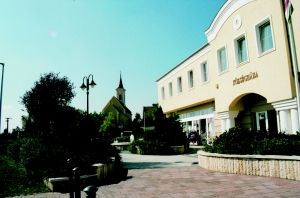Popular destinations nearby
Székesfehérvár,
Tata,
Tatabánya,
Bakonybél,
Dunaújváros,
Eplény,
Gárdony,
Komárom,
Pápa,
Várpalota,
Velence,
Zirc,
Ajka,
Alcsútdoboz,
Ászár
|
A large village of 3,132 inhabitants in county Komárom-Esztergom, in the eastern corner of Kisalföld. It is situated 5 km from the national highway M1 and is connected to it by main road No. 13. Győr is 35 km, Tata is 23 km, and Komárom is 13 km from here. The village is crossed by 5 brooklets. It was first mentioned in records in 1233 under the name Wygman. It was depopulated several times during the Turkish occupation and it was not until 1643 when László Csáky, the owner of the Castle of Gesztes brought Calvinist Hungarians here to settle down. The Catholic church was built in 1775-1777, according to the plans of Jakab Fellner, and the parish was built in 1749. The Calvinist church, which can still be seen, was built in 1889. During the Napoleon wars the French destroyed the village in 1809. In the war of independence of 1848-49 Haynau had his headquarters here. The Roman Catholic priest, Antal Csákberényi Mansbart, 27, and the Calvinist priest János Csákberényi Szikszai, 50, were executed here, because in their churches they announced the recruitment ordered by the government and the Declaration of Independence. Their tombs can be seen in the Catholic cemetery. To commemorate them, a black obelisk was erected by the inhabitants next to the Calvinist church. In 1862 the pharmacist of Komárom, Antal Scmidthauer discovered the springs of the bitter water of Igmánd which became very famous. As a result of careless usage of agricultural chemicals, the water of the springs is not used today because of its high nitrate content. To commemorate the 99 heroes of Nagyigmánd, who died in World War I, a monument was erected in Heroes´ square next to the local council hall and the Catholic church. In the Memorial Park of World War II a black obelisk was erected in memory of the 118 victims of Nagyigmánd. Next to it, near brooklet Szendi you can find the statue of St. John of Nepomuk. The school of the village, where children of four villages are educated, was named after linguist professor József Pápay, who studied the heritage of Antal Reguly researching the origin of the Hungarian language. The Calvinist priest and writer, Károly Szentkuti Kiss died in Nagyigmánd in 1928. Lajos Harsányi, writer and poet was born here, too. The writer, poet and editor, József Szamosi, the honorary freeman of the village, who lives in Munich now, regards Nagyigmánd as his home village. Professor of pedagogy, Dr. Sándor Vendégh became the honorary freeman of the village in 2005. The village awaits visitors with a community centre, a library, a guest house, a restaurant, while the lovers of fishing can enjoy the beauty of the lake near the road to Szendi. Outstanding annual events: the Spring Folk Dance festival on Matthias Day, the Wine competition of the Vine-growing Community, the fair on St. George´s day, the day of Nagyigmánd, the day of the farmers of Ördöghegy, the Day of Hills on Peter´ Paul´s Day, the Puszta day, Vintage procession, a feast on St. Michael´s day and a Marathon race. Next to the road to Szendi, 7 km from Nagyigmánd you can visit the picturesque Ghyczy mansion and lake. Pictures of Nagyigmánd
|
Nagyigmánd map nagyítása >>
|
|
|
Hungary - Nagyigmánd |
|
|
|
||
|
Friday, 11. April 2025. - 01:25:16 |
||
